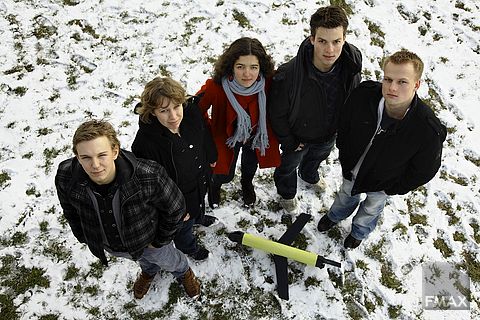Students in 3mE’s Toptrack programme have improved the design of a super-silent autonomous underwater vehicle (AUV). Last Friday they presented their results and were rewarded a ‘9’.
In total silence the pointed yellow cylinder glides downwards in the water towards the deep darkness below. At a 45-degree angle, it travels both steadily and stealthily, propelled by nothing more than its own weight. Slowly it descends. At about a meter per second, it’s a bit slower than the speed at which an average person walks. Still, after just fifteen minutes it has reached a depth of 700 metres and approaches the ocean floor. Time to rise. A short humming sounds as an electromotor pumps out half a pint of seawater. This lowers the sub’s density below that of the surrounding water, which, according to Archimedes, makes it want to go back up. Simultaneously, inside the sub the battery pack is slightly tilted rearwards, shifting back the point of gravity and pointing the sub’s nose toward the surface.
Thus zigzagging through the ocean’s depths, the silent sub can continue its journey for months at a time, since it uses very little energy. This feature makes AUVs highly suitable for performing long series of measurements of ocean temperatures, seawater salinity or ocean currents. It must have military applications as well, or else Nato’s Underwater Research Centre (Nurc) in northern Italy wouldn’t be working with them.
A disadvantage of using such AUVs is that they must be launched in deep water, or else they cannot really zigzag. The researchers at Nurc would like to launch their subs from a bay, and wondered if the craft could be equipped with a small propeller for horizontal cruising through shallow waters. This question, relayed by professor Daniel Rixen (Mechanical, Maritime and Materials Engineering), proved to be a fertile starting point for a six-month project for twelve talented 3mE students in the Toptrack programme.
The students started out by phrasing the question more generally, and made a computer programme that allows the user to design an AUV with length, diameter, wings and curvature chosen at will. The software then calculates the resulting centre of mass, the pressure points at the wings, the centre of pressure of the craft and other design specifics. The group adapted the Matlab model that researcher Maaike Schilthuis developed for this purpose. Eventually the behaviour of the sub can be simulated and displayed in animations.
To validate the mathematical model, the students entered an existing design of a sub, called Slocum, and compared the simulation outcome with documentation of sea trials. Their results were within fifteen to twenty percent of the actual trials, which is regarded as satisfactory.
Back to the original question: can the sub used by Nurc be equipped with a small propeller and electromotor without jeopardising its stability and performance? The students have shown it can be done using a 5-centimetre diameter propeller and a 5-watt engine. Further details however may not be furnished under the non-disclosure agreement the students were obliged to sign.
Another improvement the students came up with was an energy-efficient control mechanism. Uncontrolled UAVs, as is the default, may stray hundred metres off target over a distance of one kilometre. Pepijn Cox and his colleagues developed a navigation device based on the output of an acceleration sensor. In principle speed and also distance can be derived from the acceleration, but the method is prone to large errors. By choosing an accelometer with the right specs the students succeeded in extracting usable navigation information from it. Steering is done by slightly shifting the internal mass. Simulations show that the margin of error on a one-kilometre track could be reduced to 30-40 metres.
Last Friday, the students were rewarded a grade of ‘9’ for their project. The Italian firm producing Nurc’s subs seems interested in implementing the propulsion system, thus making the world’s first hybrid AUV.
Toptrack is a plus programme at 3mE open to the top 5 percent of its BSc students. The 2010 Challent kickoff will be held on Thursday, February 18, at the Meisjeshuis, from 16:00-20:00 hrs.
Elk jaar weer geven ze op 30 april wat extra jeu aan de koninginnedagviering: het groepje leden van de Delftsche Studenten Bond dat, gekleed in studentikoze rokkostuums met baret, willekeurige voorbijgangers – en zichzelf – vergast op heerlijke glaasjes oranjebitter. Bestuurslid Jan-Willem van Bers dook diep in de verenigingsalmanakken en ontdekte dat de traditie ontstond in de jaren zeventig van de vorige eeuw. Wanneer exact en waarom, kon hij niet achterhalen: “Er staan vage opmerkingen in genoteerd, zoals ‘We hebben er oranjebitter bij geschonken, het was een mooie actie’.”
Rond tien uur ’s ochtends komen de Bondsleden bijeen op de sociëteit. Dan maakt de president onder luid gejuich het nieuwe bestuur bekend. Wat overigens de laatste drie jaar niet gelukt is, vertelt Van Bers. “Het wordt steeds lastiger om nieuwe bestuursleden te vinden.” Vervolgens tijgt de groep naar de kermis op de Paardenmarkt, waar de oranjebitter niet alleen wordt uitgedeeld aan omstanders, maar ook door de studenten zelf wordt verorberd, gezeten in de botsautootjes. Bij het stadhuis gearriveerd, laat de groep aan de bode weten de burgemeester even te willen spreken. Dan is het ‘moeilijk moeilijk’, aldus Van Bers, maar uiteindelijk komt de burgervader toch altijd even tevoorschijn en wordt met hem massaal het glas geheven, onder het slaken van de kreet ‘Adtje!’. Niet de voornaam van de burgemeester, maar de in studentenmilieus veel gebruikte afkorting voor ad fundum: het in één teug tot op de bodem leegdrinken van het glas. Daarna wordt op en rond de Oude Delft tot ver in de namiddag de oranjebitter vanaf dienbladen geschonken en genoten.



Comments are closed.